MOTOism: Let's Fillet a Fluke
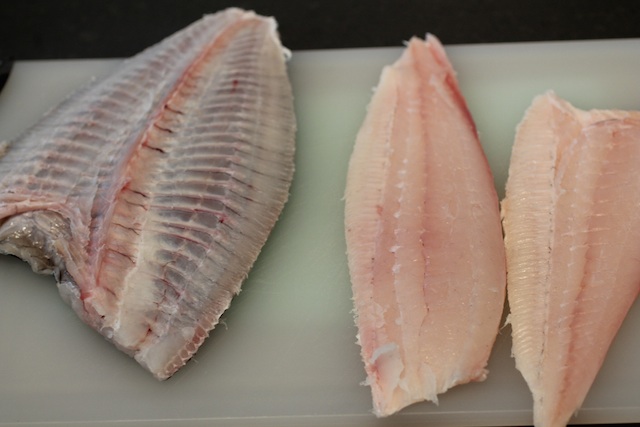
Fish is still something a lot of people are scared of in the States. Heads, guts, scales, filleting -- there are a lot of processes involved before you can eat a piece of fish. It is the same process for meat or poultry, and I am sure butchers go through a lot of steps to serve us beautiful meat or chicken. Butchering a whole cow may be a bit much (how many servings does a whole cow yield?), but buying a whole fish and filleting it yourself:
a) makes you look like a pro
b) you feel like you are a surgeon
c) you get parts that don't come in a pre-filleted piece of fish
d) it's a fun activity.
The most important things when buying a whole fish that you can eat raw is to go to a trusty fish monger. You also must have a sharp knife since you are cutting flesh. A dull knife is basically the main cause of a sad (literally dull-looking) fillet of fish.
I was at Lobster House in Chelsea market, and asked if they have a fresh whole fluke, and they did. Fluke is probably the safest choice in New York for a whole fish that you can eat raw since they are usually locally-caught in Long Island. By the way, I heard the New York area is the only place to call it "fluke", everyone else in the country call the same fish as "summer flounder", or simply "flounder". Don't ask me why.
At the fish monger, the easiest way to see if the fish is fresh is to sniff it. If you don't smell much, that's a good sign. If you smell fish, don't get it. Also if you see a bunch of whole fluke at your fish place, choose the one that's the thickest. It's a lot easier to fillet a thicker fluke than a thin one.
The pros will buy the fish as is, and gut and scale it themselves, but I thought it was a bit too much work and I didn't want scales all over my kitchen, so I asked them to gut and scale the fish for me.
Let the surgery begin! Fluke is a truly ugly looking fish, but has beautifully mild and pale white meat.

Remove the head and tail fin. Professional sushi chefs will only fillet meat and leave the the rest to use as a serving dish or something, but this is at home, and you don't want to see the fluke's head, which isn't appetizing.
If you have a mallet, you can go at it and chop off the head, as arrowed below.

You really have to force it, like stabbing someone. Forceful entry is the key. If you hesitate, not only will the cut be dull, but you may hurt yourself. Think of yourself as a killer at this point, and really go at it -- it's the best way to cut through the bone. I wonder if this is the same teaching method at OR training.

Once the head and tail are removed, wash the fish. This is the last time you are exposing the fish to water, so wash thoroughly. This is important: when dealing with fish, you don't want it to have too much contact with water, so this is it. Wash it well inside out.
Next, use kitchen shears and remove the fins. Be sure to cut into flesh (after the cut, a small part of the flesh should be exposed). We don't want any part of fins left.

Pretty cleaned up, and keep patting dry.

Now this is the end of Day 1. You wrap this in double layer of paper towel (don't skimpy on this, get Bounty or something respectable). Wrap the whole fish tightly, then wrap is with saran wrap (again, tightly), and put it in the fridge overnight.

By wrapping with paper towel, it absorbs any remaining water from the fish, and they do have a lot of water inside their flesh, so it's very important to wrap tightly.
Fluke face is truly ugly.

What I don't understand is how they can see things since their eyes are located so close to each other.
Now some people may be wonderding why I am resting the fish overnight. Fish develops inosine acid after they die, and this is umami part of fish. If you go to a place where they kill a fish in front of you and serve very fresh fish, it's fresh, but flavor is less. Some tuna fish are aged for up to a week before serving as sashimi, to develop its umami to the maximum.
Day 2: this is the real part of filleting fish. Take it out of the fridge, and it shouldn't be wet. It should look pretty dry like the picture below.
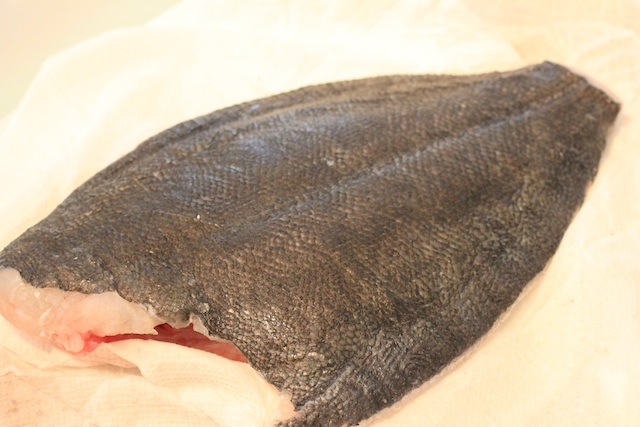
Flip to the back side, and make a thorough incision on top of the spine.

There's a line you can see in the center, where you want to cut through until your knife touches the spine. If you have a knife with a pointy top, that will be the most ideal, but as long as you have a sharp knife, it will do the job. I used a regular knife.
Then gently slice the flesh off the bone. This seems hard, but you just keep cutting right on top of the bone, and it's easier than you would think.

Try to get as close to the bone as possible.

Do the same on the front side.
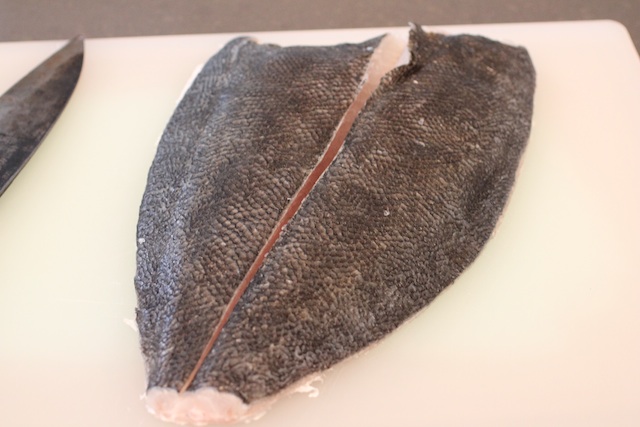
As you can see, I caught a bit of bone on this side, but you can slice them off, so don't worry about it.

It's a good sign when you can see through bones after filleting, rather than having a lot of flesh left.

Now it's time to skin. Separate the flesh and engawa (the muscle that controls the fins. Its texture is crunchy and this part is very expensive at sushi restaurants, so do not discard these babies). You can insert your fingers and it easily separates.

Cut off the engawa. Now you have another piece of fillet.

Then you want to skin the fillets. It was too difficult to take pictures, but you cut a small part of the end flesh to use as a grip, then try to skin it by pulling the grip and pushing the knife along the chopping board. You need to get the knack of it, and once you do, it's not hard. If you have a bit of skin left, that's fine, you can cut ot off later. Repeat this for the other three parts.
Four pieces of beautiful fluke sashimi is now done.

What I didn't think about when I bought the fish was, consumers. Since shelf life of fresh fish isn't that long (though it can still wait a day or two from this point), I needed to do something to prolong it.
One easy way to do it is to cure with konbu (kelp).
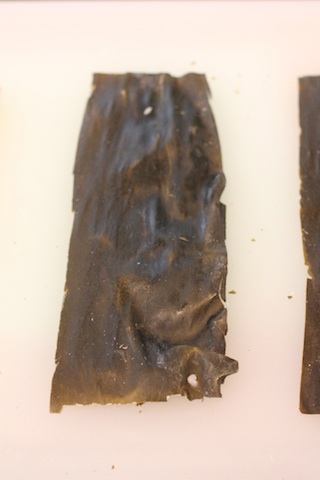
Cut konbu into the size of fish. Wipe konbu with a sake-soaked paper towel.

Sprinkle salt on the fish, then sandwich it with another piece of konbu.
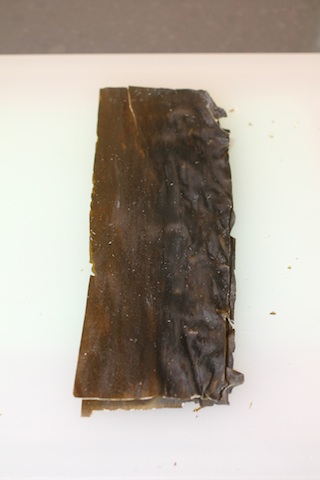
Wrap it and put it in the fridge. You can either leave it for a day or two to have a stronger flavor of konbu, or put it in the fridge for a couple of hours, which I like better. The effect is significant. Not only does it add konbu flavor, but the texture changes significantly. I cured half of the fillet, and the difference was pretty obvious. Regular fillet is fresh, but pretty mild and somewhat boring (hence I marinated with ponzu, olive oil, and black pepper), but konbu-cured fillet had a sticky, almost mochi-like texture. It was very interesting to see how much of a difference it makes just by wrapping in konbu.
For the engawa, you need to skin just like the fillet, then cut them into small chunks.

This was a bit more fishy than the rest, so I marinated this in soy sauce, a lot of grated ginger and Pietro (yep, I used Pietro again).
After everything is marinated and ready to serve, I played around and made a good-looking appetizer plate.

You can buy bamboo leaves (food grade) at Japanese houseware stores. In NYC, Korin sells 100 vacuum sealed leaves.
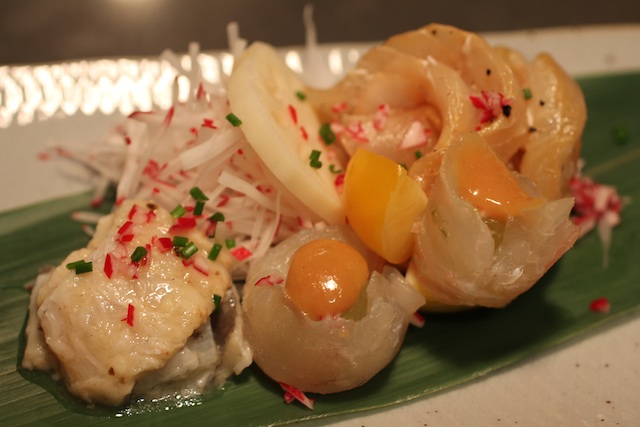
Left is marinated engawa, and on the right are konbu-cured pieces are wrapped with peeled grape tomatoes, topped with karashi-sumiso (miso, vinegar and Japanese mustard sauce). Top right is ponzu/black pepper marinated fillet. Each piece tasted a bit differently because of its texture as well as how I marinated them.
I also made sushi rolls, using fluke, fake crab meat (for a bit more flavor) and lettuce for crunch, and chive for some punch.

This continued for twonights (I marinated differently the second night, but it was basically a fluke-galore dinner). At the end Nate said, "I want chicken and potatoes."
One sad thing about buying a whole fish was, it was $7.95 lb, compared fo $12.95 lb for a piece of pre-filleted fish. Once the head, tail, fins, bones and skin is taken off, it probably is more expensive than a pre-filleted fluke. However, you can only get engawa when you buy a whole fish, and the process is so much fun (not for everyone, I know, but it was a lot of fun for me).
I don't have any interest of actually going fishing, but if you catch fresh fish, you can bring it to me, and I will happily fillet it.
Next, I need to try Black Seabass, which is also locally caught and will be easy to find a fresh one.
